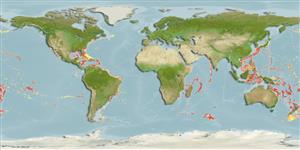Environment: milieu / climate zone / depth range / distribution range
Ecologia
marino benthopelagico; distribuzione batimetrica 260 - 775 m (Ref. 57911). Deep-water
Widespread in tropical Atlantic and Indo-West Pacific Oceans.
Size / Peso / Age
Maturity: Lm ? range ? - ? cm
Max length : 37.1 cm TL maschio/sesso non determinato; (Ref. 13608)
Short description
Morfologia | Morfometria
Vertebre: 133 - 141. This species is distinguished by the following characters: with pectoral fin; dorsal-fin origin over tip of pectoral fin, predorsal length 14.0-17.1% TL; anus posterior, more than 1 head length behind pectoral fin, preanal length 26.8-28.8% TL; trunk long, trunk length 12.8-16.4% TL; intermaxillary teeth absent; vomer with 4 compound teeth; upper and lower jaws with multiple rows of teeth; head pores: IO 4, SO 3, M 6, POP 0, AD 1, ST 0, F 0; lateral-line pores absent; MVF 11-28-136, total vertebrae 133-141; colour of body light brownish dorsally, paler ventrally; dorsal and anal fins with white margin, posterior one third of anal-fin base and posterior one-seventh of anal fin black (Ref. 106136).
On the continental slope (Ref. 57911).
Life cycle and mating behavior
Maturità | Riproduzione | Deposizione | Uova | Fecundity | Larve
Uyeno, T., K. Matsuura and E. Fujii (eds.), 1983. Fishes trawled off Suriname and French Guiana. Japan Marine Fishery Resource Research Center, Tokyo, Japan. 519 p. (Ref. 13608)
IUCN Red List Status (Ref. 130435)
Threat to humans
Harmless
Human uses
Informazioni ulteriori
Nomi ComuniSinonimiMetabolismoPredatoriEcotossicologiaRiproduzioneMaturitàDeposizioneSpawning aggregationFecundityUovaEgg development
Age/SizeAccrescimentoLength-weightLength-lengthLength-frequenciesMorfometriaMorfologiaLarveDinamica popolazioni larvaliReclutamentoAbbondanzaBRUVS
BibliografiaAcquacolturaProfilo di acquacolturaVarietàGeneticaElectrophoresesEreditarietàMalattieElaborazioneNutrientsMass conversion
CollaboratoriImmaginiStamps, Coins Misc.SuoniCiguateraVelocitàModalità di nuotoArea branchialeOtolithsCervelliVista
Strumenti
Special reports
Download XML
Fonti Internet
Estimates based on models
Preferred temperature (Ref.
123201): 6.8 - 15.4, mean 10.1 °C (based on 336 cells).
Phylogenetic diversity index (Ref.
82804): PD
50 = 0.7500 [Uniqueness, from 0.5 = low to 2.0 = high].
Bayesian length-weight: a=0.00102 (0.00046 - 0.00225), b=3.06 (2.88 - 3.24), in cm total length, based on all LWR estimates for this body shape (Ref.
93245).
Trophic level (Ref.
69278): 3.8 ±0.3 se; based on size and trophs of closest relatives
Resilienza (Ref.
120179): Basso, tempo minimo di raddoppiamento della popolazione 4.5 - 14 anni (Assuming tmax>10).
Fishing Vulnerability (Ref.
59153): Low to moderate vulnerability (27 of 100).
